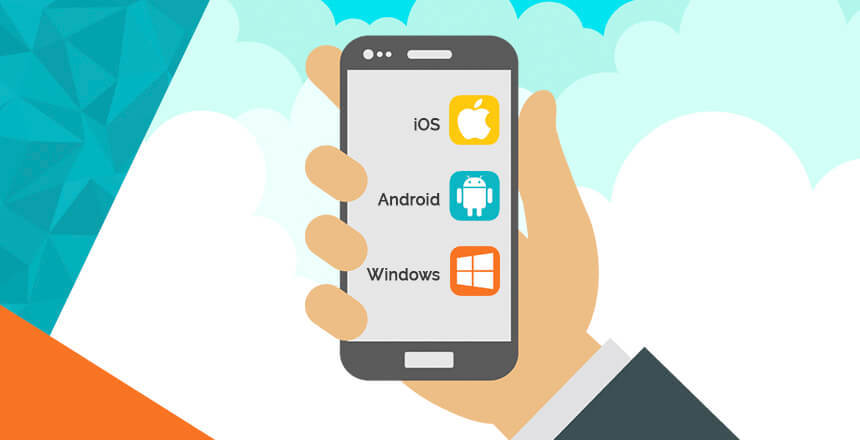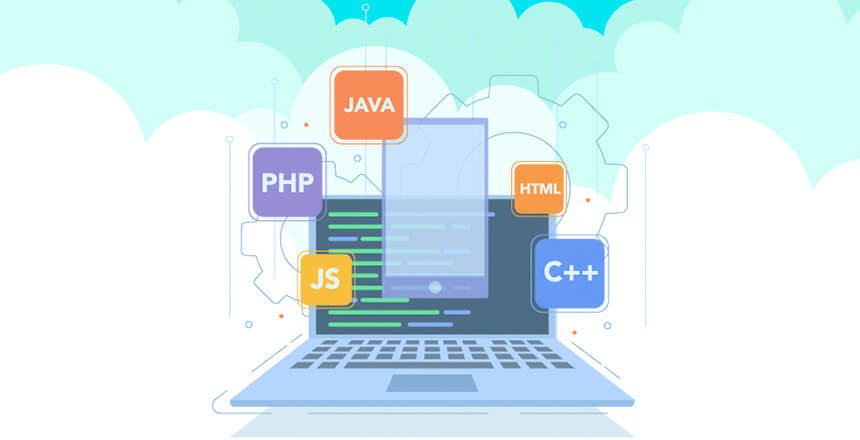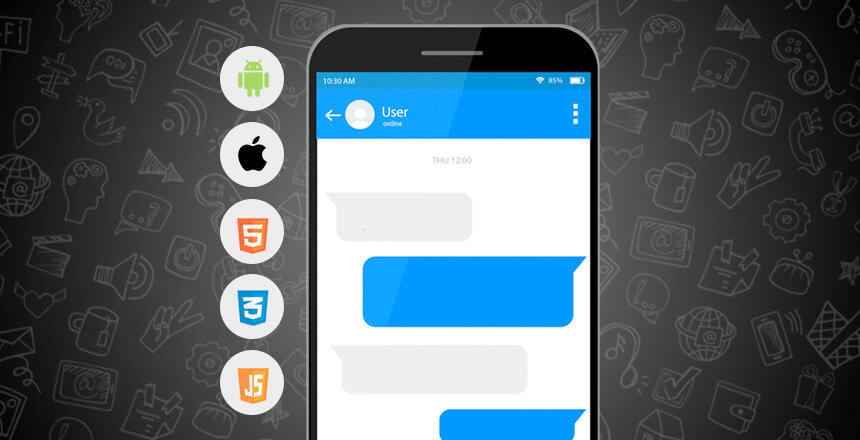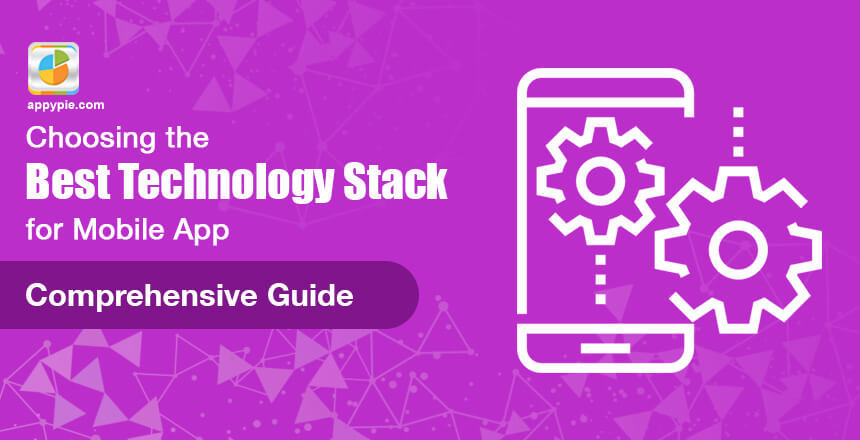How to Choose the Best Technology Stack for Mobile App Development?

Whether you are a novice or an expert in the field of mobile application development, you must have often come across the term Technology Stack in various contexts.
Table of Contents
- Technology Stack – What is it?
- Finding the Best Technology Stack – Why is it important?
- Native App Technology Stack
- Technology Stack for Android Mobile Apps
- Technology Stack for iOS Mobile Apps
- Technology Stack for Hybrid Apps
- Technology Stack for Cross-Platform Apps
- Backend as a Service (BaaS)
- Platform as a Services (PaaS)
- How to choose the best technology stack for a mobile app development project?
- Conclusion
Now, you can choose the method of app development as per your preferences, but if you do not have a robust technology stack to support it, you are setting your app up for a failure. The choice of the technology stack plays a defining role in how the mobile app would perform with the users.
Technology Stack – What is it?
A technology stack forms a critical part of creating any application whether it is for the web or for the mobile platform. The term is often used to refer to a combination of programming languages, tools, and software behind a development project.
The tech stack for your mobile application is quite like the skeleton made up of frameworks, languages, and software products that is the very foundation of the final product.
- Frontend Development
- Hyper Text Markup Language – HTML
- Cascading Style Sheets (CSS)
- JavaScript
- WebAssembly
- Backend Development
- Development Platform
- Additional Requirements
Frontend development is essentially the interface of the mobile app used by the app users to interact with and navigate through the app. There are multiple tools and platforms available which help develop the front end of a mobile app. The knowledge of which tools work the best for a particular task and mark the difference between developing a site that will falter or get hacked and a site that is designed well and is scalable. The primary tools used for front-end development include:
A frontend developer has two major points in consideration while developing any project – accessibility and performance. There are multiple mobile devices including multiple types of smartphones and tabs which is why it is important that the designers make sure that the app looks consistently great in devices of all sizes and resolutions. The performance goals primarily are related to the render time, HTML, CSS and JavaScript manipulations so that the load time is lowered.
Backend development is a critical part of mobile app development that is responsible for data storage, security and business logic. The backend of a mobile app is quite like a server for mobile apps because it stores and sorts all the important information that the end users do not see. In general, not all mobile apps need a backend, but increasingly a number of apps are now beginning to incorporate a backend as a typical development for mobile apps. This is primarily because of some of the new features that may require storing and sorting critical user or company-based information.
The basic backend development tools you need for mobile apps include – language and frameworks, web servers, database management systems, microservice platforms, local development environments, collaboration services, and website performance testers.
A development platform or particularly a mobile app development platform (MADP) is a kind of software that lets businesses create, test and launch their mobile apps in a short time for smartphones and tablets. It is possible to create a mobile app development platform on your own, but many organizations also buy a third-party product for the same.
Third-party MADPs generally include multiple features like mobile Backend-as-a-Service (BaaS), tools for frontend development, and management tools for APIs. The MADPs may also offer native, web, and hybrid app development capabilities in addition to mobile application management (MAM) tools. While choosing a suitable MADP for your mobile app, there are many decisions you may need to make, including choosing between cloud-based or on-premises service and between codeless or low-code among many others.
This is a ‘catch-all’ umbrella which consists of any additional technology elements that have an impact on the performance of the app, its security, and on its overall robustness. These additional requirements may also stem from any particular requirements of considerations of the project.
After you have understood what a technology stack means, it is time you explored the reasons why businesses must sit with the app development professionals or the company that they have hired and discuss the technology stack that would go into building the mobile app.
Finding the Best Technology Stack – Why is it important?
Numerous defining traits of the mobile app you are building depend on your selection of the technology stack for the mobile app. It is what would decide whether the app is robust, or will the app be able to scale to various versions of different operating systems, and many such other traits.
Choosing anything but the best technology stack is sure to affect the immediate performance of the app and mar its future growth prospects. The time to market of the app and the cost of app development are only the most obvious and the initial issues you would face but choosing the wrong tech stack can actually lead to more deep-rooted problems in your app altogether!
It is time now to look at the technology stacks that are behind the development of robust, scalable, and unique mobile and web apps.
Native App Technology Stack
Preferred by most companies for their robustness and high performance, apps present themselves as a near perfect solution when it comes to mobile app development for business. A native app lets the developers integrate the device’s in-built functionalities in their mobile app without having to rely on any external third-party API.
When you think about a native app it is natural that iOS and Android apps would pop up in your head. Now, both the platforms are different in their construct, which means that you would have to choose entirely different technology stacks for both of them.

Technology Stack for Android Mobile Apps
While building a native mobile app, if you decide to go with Android, then you must think about including the following technologies in your tech stack.
- Programming Languages: Java, Kotlin
- Toolkit: Android Studio & Android Developer Tools
- Software Development Kit (SDK): Android SDK
Two of the best programming languages for native mobile application development include Java and Kotlin. Java has been around for some time now and has established itself as a programming language with vast open-source tools and libraries that support the developers. In the recent times, however, Kotlin has presented itself as a more stable and congruous development option for Android Studio. Java has some limitations that hinder Android API design. Kotlin was designed particularly to overcome these shortcomings and is inherently lightweight, clean, and a lot less verbose while offering solutions to deficiencies in API design. Kotlin particularly helps you with smooth transitions between screens and animated micro-interactions.
Android Studio is popular because of its unique offerings including code editing, debugging, performance tooling, a flexible build system, and an instant build/deploy system. The toolkit is particularly popular among android app developers because it gives you the freedom to focus on building unique and high-quality apps.
Android Developer Tools (ADT) gives you complete support for Android app development. However, this toolkit is not restricted to offering only Android-specific coding support, it also enables the developers to leverage multiple on-device debugging tools, graphical UI builder, emulators and fully scriptable test automation support.
Developers who are writing programs with the latest features need to download and install each version SDK for a particular phone. The components or tools that make up the Android SDK can be downloaded separately. Also, third-party add-ons are easily available for download.
Technology Stack for iOS Mobile Apps
If however, you plan to get into native iOS mobile app development, you would have to look at a whole different set of tools or technology stack. Let’s take a look.
- Programming Languages: Objective-C, Swift
- Toolkit: Apple XCode
- Software Development Kit (SDK): iOS SDK
The two most preferred languages for iOS mobile app development today are Objective-C and Swift. On its own Objective-C is essentially a superset of the popular programming language C, and offers object-oriented capabilities and a dynamic runtime environment.
However, the developers prefer the comparatively new iOS programming language Swift because it is more functional and offers a less error-prone code. This is largely because of its inline support for manipulating text strings and data and includes dynamic libraries which are uploaded directly to memory which eventually reduces the initial size of the app hence enhancing the overall performance of the app.
Once you have opted to work with Swift for creating your own native iOS mobile application, you would need to work with Apple XCode. It is a full featured toolkit or a development environment that lets you create mobile apps and desktop applications.
In all, XCode is quite resourceful for iOS app development as it includes among other things, integrated support for Git repositories, an efficient graphical editor for building engaging user interfaces, instrumentation and debugging tools, and integrated documentation.
The iOS SDK comes with an Application Programming Interface (API) that effectively works as a link between the software applications and the platform they run on. Now developers can create the APIs in multiple ways and come with helpful programming libraries and other tools.
The iPhone SDK offers specialized tools for Apple’s touchscreen interface and for its proprietary operating system iOS. iOS incidentally is used for running apps on iPhones in addition to other mobile devices like the iPad.
Technology Stack for Hybrid Apps
Hybrid app development uses a shared code wrapped in a native container and then shipped off as a regular app. Let’s take a look at the available frameworks for hybrid application development and how they work.
- Cordova/PhoneGap
- Ionic
An open-source framework, Apache Cordova is great for running HTML/JavaScript-based applications inside a special native container on a mobile device. JavaScript APIs are responsible for exposing native device functionality, which is why HTML-based apps have the ability to access device-specific features like a variety of sensors and cameras.
The good thing here is that the developers do not have to depend only on HTML and CSS to create the user interface because PhoneGap offers support for multiple frameworks and libraries including jQuery, AngularJS, and Knockout.js to name a few.
An Angular JS based framework, Ionic shares a bunch of advantages and a pretty active supporting community with the popular framework. In hybrid apps, it is critical to have a native look and when using Ionic, this is achieved quite successfully.

Technology Stack for Cross-Platform Apps
Cross platform app development may serve your purpose the best and the tech stack for this kind of app development is different. Let’s take a closer look!
- React Native + JavaScript/TypeScript
- Xamarin + C#
React Native is the most popular JavaScript framework that can be used to write mobile apps with the look and feel of native apps for both iOS and Android platform. The framework is pretty convenient as it uses pretty much the same fundamental UI building blocks as the native iOS and Android apps. The only difference is that, in case of cross-platform mobile apps you would be putting together these elements or building blocks using JavaScript and React.
React Native, the framework is responsible for introducing a novel, radical, and highly functional approach towards creating user interfaces. Using React Native, the app logic I written and run in JavaScript, but the UI of the app would be entirely native.
Alternatively, you can also use TypeScript as a language with React and create a cross-platform mobile app. While using TypeScript with React Native you get some great features for quick and simple error detection. These apps developed using React Native and TypeScript also get an extra layer of security tightening the feedback loop and helping you find the errors quickly.
Xamarin is a pretty handy tool that is preferred by developers for cross-platform mobile app development. The tool lets the developers share almost 90% of the code across all the major platforms. The tool works with C# as the primary language for cross-platform app development. C# is a strongly preferred as it is a statically typed language with mature tooling and IDE support. C# mobile apps are cross compiled to native Android and iOS binaries. In this method, you can also use device specific APIs and functionality from within C#.

Backend as a Service (BaaS)
Backend as a Service (BaaS), also known as Mobile Backend as a Service (MBaaS) is essentially a cloud computing service model that helps mobile app developers with a solution to connect their apps to backend cloud storage and APIs exposed by back end applications while offering features like user management, push notifications and social media integration. These services and features are made possible through custom SDKs and APIs.
Platform as a Services (PaaS)
Platform as a Service (PaaS) also known as Application Platform as a Service (aPaaS) is a type of cloud computing service model that provides a platform to help the customers develop, run, and manage applications without having to deal with the complicated processes of creating and maintaining the infrastructure associated with building and maintaining the infrastructure associated in general with developing and launching an app.
How to choose the best technology stack for a mobile app development project?
There are multiple technology stacks that you can choose to start working with. However, when you are on your way to pick the one that suits you the best, you must have a strong plan in place. This ensures that the mobile app you develop is professional and functional apart from being scalable, maintainable, and secure.
While developing this plan, it is essential that you pay attention to certain critical points that play a big role in the decision making.
Let’s take a look!
- App requirements
- Goals of the app
- Skill set within the organization
- The company that made the technology
- Ability to operate on multiple platforms
- Security issues
- Compatibility with technology you are using already
Each app is different from the others in many different ways. The devices on which the app would have to function, the kind of network conditions it would have for operation, the intended user experience, the go to market time, and the platform it would run, and many such other factors differentiate one app from the other.
All these elements and more, come together to help the developer decide which framework, library, language, and software they should use to attain the best results.
The objective or the end goal of the app is critical in the technology stack a developer picks for developing the app. For example, the technology stack would wildly differ for developing an app with high latency as compare to a quick response mobile app with low latency.
If the mobile app is dependent on heavy load processing, then there is a need for a more robust technology stack as compared to an app that operates around precisely streamlined interactions.
There are quite a few languages and frameworks that bear similar results, but have certain typical differentiating factors distinguishing one from the other. If you were to decide between two technology stacks which are pretty close to each other, it is a good idea to go with the developer’s strengths.
If you end up pushing your development team to pick a tech stack that they are not familiar with, then the efforts would increase, and so would the time taken to build it. However, if you were to offer them a technology stack that your team is familiar with, not only would the speed of the process be better, but the quality too is bound to be better.
The parent company of your chosen technology stack is of critical importance in the development of your mobile app.
Some of the more established brands that provide a better documentation and community support as compared to the others. It is only natural that Google, Microsoft, and Adobe would provide much better community support and advanced development options as compared to using Facebook with React Native.
If we compare an app that runs on a single platform to an app that would run on all the platforms, there would be a world of difference between the technology stacks chosen to build the two. Similarly, the tool set required for the kind of scalability you would require incorporating in your mobile app in order for it to be ported on other platforms, like in Hybrid or Cross Platform App Development would be entirely different from the tool set required for Native App Development.
Any modern-day mobile app development technology worth its salt, is equipped to ward off any weaknesses in the security that an app might encounter after it has been released in the market. However, it becomes tricky when the tech stack you chose is insufficiently documented or requires writing long codes increasing the risks during the entire process of development.
A critical consideration here is the skill level of the developer. Irrespective of your choice of technology stack you are including in your mobile app, the hackers would wind any weak spots you might have left during the process of development. This is why along with the choice of technology stack, your team of developers need to be fairly skilled as well.
It is of absolute importance to choose a technology stack which is compatible with the technology that you have already been using in the project. This is especially important if you plan on introducing a new technology stack after the process of mobile app development has already begun. Also, while it is important to check the compatibility of your chosen tech stack with the current technology set in the project, it is also important that you check for compatibility between the tech stack and any other tools that you are planning to introduce in the project later on.
Conclusion
There are a number of elements in mobile app development that depend on your choice of technology stack. The technology stack you choose for your mobile app decides whether the app would be robust or not and define future scalability (or the lack of it). Choosing the wrong or unsuitable technology stack would not only put a damper on the current performance of your app but will also limit any future prospects of growth.
For those who have clarity about what they want for their business and where their target users are, this choice is simple. However, if you do not possess the skill, time, or budget needed for custom mobile apps, Appy Pie’s app builder is the perfect place to start. What else is stopping you, go ahead and get started now!
Which technology stack have you been using for your mobile app? Let me know in the comments section, I would love to know!
Related Articles
- Tuples Explained in Swift
- JPMorgan Chase would soon be Launching a Free Investing App for Traders!
- 10 Best Vend Integrations for POS & Inventory Management
- How To Become A Remote Developer
- 5 Ideas for Conversational Chatbots With Quizzes
- Quit Coding? Here’s How To Start Building Apps Again
- Let’s Solve The FizzBuzz Challenge in Swift
- 5 Best Meeting Agenda Templates and Examples
- NFTs – The Future of Fashion (Podcast 104)
- Why You Need CRM Software for Your Business?
Most Popular Posts
 Photoshop Alternatives: Top 10 Graphic Design Tools in 2024
Photoshop Alternatives: Top 10 Graphic Design Tools in 2024 By Deepak Kumar | July 25, 2024
 Canva vs Appy Pie Design – Which is Better?
Canva vs Appy Pie Design – Which is Better? By anupam | July 18, 2024
 Canva Alternatives: Top 15 Graphic Design Tools to Replace Canva in 2024
Canva Alternatives: Top 15 Graphic Design Tools to Replace Canva in 2024 By anupam | July 18, 2024
 Canva Review: Key Features, Pros, Cons & Pricing
Canva Review: Key Features, Pros, Cons & Pricing By anupam | July 18, 2024
 8 Best ManyChat Alternatives in 2024
8 Best ManyChat Alternatives in 2024 By Samarpit Nasa | July 12, 2024

